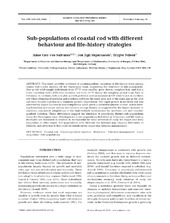Sub-populations of coastal cod with different behaviour and life-history strategies
Peer reviewed, Journal article
Permanent lenke
https://hdl.handle.net/1956/3507Utgivelsesdato
2004-02-19Metadata
Vis full innførselSamlinger
Originalversjon
https://doi.org/10.3354/meps267241Sammendrag
This study provides evidence of countergradient variations in life-history traits among coastal cod Gadus morhua off the Norwegian coast, suggesting the existence of sub-populations. One-yr-old wild-caught individuals from 70°N were smaller, grew slower, weighed less, and had a lower condition factor (CF) than southern cod from 60°N during the sampling period from June to February. In contrast, both a higher growth potential and an increase in CF were found in northern cod when offspring of northern and southern cod from the same area and of the same age as the wild cod were housed together in a ‘common-garden’ experiment. The rapid growth in northern cod was achieved by higher success in food competition when given a restricted amount of food. Active feeding behaviour and larger energy allocation to storage tissues, as suggested by the higher increase in condition, represents adaptations to the high-latitude environment for northern cod and countergradient variation. These differences suggest the existence of genetically distinct sub-populations along the Norwegian coast. Development of sub-populations that differ in behaviour and life-history strategies are discussed in relation to mechanisms for local retention of early life stages and local adaptation of older stages. Sub-populations with different life histories may respond differently to fisheries, and attention to this could be beneficial for improving fisheries management.
